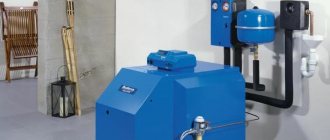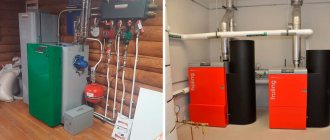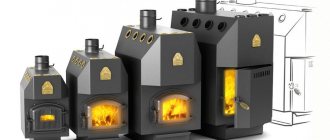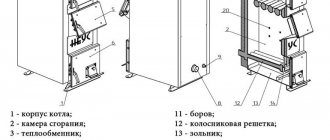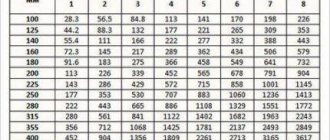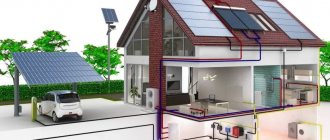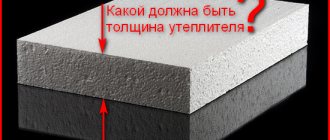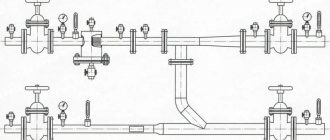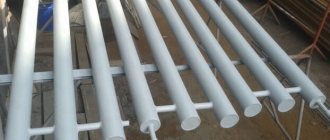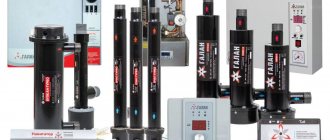High-quality heating of your own home is one of the most important issues facing its owner. And when it is resolved, a dilemma very often arises as to which heating unit will be optimal under the current conditions. Of course, if a gas main is connected to the house, then preference is given to boilers running on natural gas - such equipment has no equal in terms of operating costs. But in the case when such an opportunity is absent (gasification of a populated area is not expected in the near future) or its implementation requires absolutely “cosmic” expenses (and this often happens when it is necessary to carry out a connection from a highway to a specific building), one has to involuntarily look for other solutions.
Liquid fuel boilers - principles of operation and calculation of fuel consumption
One solution could be the use of liquid fuel - most often diesel fuel is used in this capacity, but options with used engine oil or fuel oil are possible. This option, of course, requires specialized equipment, which you need to be able to select, and at the same time, also correctly predict operating costs. Therefore, the topic of today's publication: liquid fuel boilers - principles of operation and calculation of fuel consumption.
Gas boilers
Gas boilers are heating appliances that run on gas. The gasification network is quite widespread, so such equipment is most popular among consumers.
Gas appliances are divided into wall-mounted and floor-mounted. The first ones are equipped with a circulation pump and an expansion tank, which saves space in the room. Wall-mounted boilers are single-circuit and double-circuit (they heat the coolant and provide the home with hot water for domestic needs). Equipment with two circuits is the best option for heating private houses: it is compact, easy to install and maintain.
Floor-standing gas boilers most often have one circuit and an open combustion chamber. They require a specially equipped boiler room.
A significant drawback of these boilers is the constantly increasing cost of gas.
Solid fuel equipment
Boilers operating on solid fuel (wood or coal) have a simple operating principle. The fuel is placed in the combustion chamber and ignited. Combustion products exit through the chimney.
The main advantage of such equipment is its independence from the power grid and completely autonomous operation. The downside is the preparation of firewood or coal, high fuel consumption.
What objects can be heated by a miracle stove?
Modern stoves using diesel fuel as fuel, regardless of their shape and design, are capable of heating various rooms. They successfully cope with the task of maintaining comfortable temperature conditions in the following buildings:
- country houses that do not have communications;
- separate rooms of residential suburban buildings;
- additional country buildings (sheds, outbuildings);
- extensions, basements, basements;
- garages, workshops;
- free-standing greenhouses and greenhouses;
- They can be used to heat individual tents and campsites.
Electric heating devices
Electric boilers are a convenient option for heating small buildings. Most often they are used as additional heating devices. For example, if firewood burns in a solid fuel boiler. As the main source of heating for a private home, electric boilers are used in areas where there is no gas supply. To install them, you do not need to obtain special permits or approvals.
The main advantage of such units is their ease of operation, they do not require frequent maintenance, and are equipped with electronic sensors and temperature programmers.
Reviews
Fuel is not expensive for her and does not allow her to go broke. Fully filling the tank allows you to work in the garage for up to 15 hours. I bought a small kettle, eliminating the need to run to the store to drink a cup of coffee. What a MIRACLE oven it is, you can’t call it anything else. I recommend the guys to everyone.
There's probably something wrong with his sense of smell. I don’t like its buzzing noise either; I ask you not to use it at the dacha in front of me. My husband still uses the stove secretly in my absence. I want to say that this is my pure female opinion. But if you think about those hours when there is no electricity, it really helps out.
Liquid fuel units
Diesel boilers (liquid fuel) are an ideal option for areas where there is no gas pipeline. Using such equipment, houses can be heated with diesel fuel, fuel oil, kerosene, stove and biofuel, and waste oil.
Advantages
These heating devices are gaining popularity not only because they can run on diesel fuel. They also have other advantages:
- Such equipment has a replaceable burner (nozzle), which allows you to change the type of fuel in it (for example, if it becomes possible to supply gas, you will not have to dismantle the entire unit);
- they are easy to operate, do not require frequent maintenance, the main thing is to take care of the diesel fuel supply;
- work autonomously for a long time;
- Efficiency is about 95% (provided that a high-quality burner is equipped and proper diesel fuel is used), such a boiler produces more heat than a gas or solid fuel one;
- when operating, these devices do not violate environmental standards;
- installation of the unit can be carried out without special permission;
- Almost all models have an automatic system; they are independent of external communications.
Flaws
The main disadvantage of boilers running on liquid fuel is the large expenses for purchasing diesel fuel. This will especially hit the wallet when such equipment is used intensively.
Such units require a separate room with plenty of free space. They emit soot, so you need to install a hood. In addition, the increased noise that such boilers emit requires the creation of high-quality sound insulation.
To operate them and transport fuel, you must have special components.
Diesel fuel must be stored in a separate building or equipped with a warehouse in the ground, in containers made of steel or opaque plastic, so that the sun's rays cannot harm it.
Step by step guide
Using an example, we will look at the design of a gas cylinder, since it will serve as our basis. We do not use forced air supply; it is not required here:
- We free the container from condensate and rinse it thoroughly. Then we bury it in the ground and cut off the top of the container along with the valve.
- Now we have a place for the lid. The legs should be welded to the lower part of the structure. For this we use steel corners.
- Next, cut a hole in the lid for the pipe; the size should be equal to the diameter of the chimney. We weld the pipe into the hole, making sure the seams are tight. We weld the chimney pipe to the horizontal pipe.
- We cut out a square for the blower at the bottom of the structure and install a door to regulate the air.
- Now we prepare the container for fuel. This will be a pipe (70x140 mm) and will be placed at the bottom of the gallon. We weld a piece of the pipe from below, making sure it is tight.
- We prepare a lid with two holes from a sheet of metal. Moreover, we place them in the center and along the edge. We immediately weld a pipe of equal diameter (100 mm) to the central tube. We install a movable flap (diameter 50 mm) to the second hole for filling fuel.
- We install the chimney vertically without any tilting. We choose its length 4 meters, more is possible.
- Pour fuel into the third part of the cylinder. We light a piece of paper and place it on top of the diesel fuel, and the stove lid closes. As the temperature increases, the vapors will ignite.
Construction of liquid fuel boilers
Liquid fuel boilers are made of cast iron and steel. The service life of the first is approximately 50 years, the second is no more than 10.
The liquid fuel unit consists of a combustion chamber, burner, heat exchanger, fuel purification filter, control system, and chimney.
Burner
The burner is the main element of the boiler. It mixes air with fuel in certain proportions and delivers this composition to the combustion chamber. During its operation, the energy carrier is heated, which then goes into the pipeline. Combustion products exit through the chimney, before partially giving off heat to the heat exchanger, thereby increasing the efficiency of the unit.
Burners for liquid fuel boilers can be purchased separately. A heating system with such equipment can be assembled in accordance with the preferences of the home owners. Today, boiler models with universal burners suitable for several types of fuel are sold, but the cost of these units is high.
The design of the burners is compatible with many types of water heaters and heat generators. When switching from one type of fuel to another, you need to completely clean the boiler of combustion products.
Injectors
There are several types: one- and two-stage, ventilation and diffuse.
The former operate with constant power; it can only be changed by stopping the boiler.
Two-stage nozzles operate in two modes, which allows the unit to gradually increase power.
Ventilation burners used in liquid fuel boilers force air. Diffuse ones receive the air necessary to maintain the combustion reaction from the environment.
Control
The automation of the heating device makes it possible to maintain the set temperature, ensures its proper functioning and protects it from dangerous operating conditions.
An oil-fired boiler depends on electricity. It must have an independent source of energy: then the equipment can operate autonomously.
Fuel tank
Such units have an additional capacity of no more than 50 liters (if the heating device is located in one of the main rooms of the home) for diesel fuel; it is often installed near them.
Tanks with a volume of up to 1000 liters are installed in a specially equipped room.
Design
- A fuel tank that is removable and has a valve.
- Adjustment screw.
- Block with a wick.
- Removable grid.
- Reflector.
- Burner.
There is a reflector on the body; it is painted with powder dye. The heating of the building depends on it.
The burner is located in the center of the structure.
The fuel tank, located at the rear of the device, supplies fuel to the wick bowl by gravity.
The control valve sets the heating power.
They are mainly made of fire-resistant steel and can weigh up to 10 kg in weight. The compactness of the device allows it to be transported to various places.
Types of liquid fuel equipment
Depending on different parameters, several types of units are distinguished.
By the number of heating system circuits
An oil-fuel boiler can be single-circuit or double-circuit. The latter are equipped with two heat exchangers, which allows not only to heat the house, but also to provide its residents with hot water for domestic needs. Naturally, their fuel consumption is higher than that of single-circuit ones.
By type of injectors
Boilers operating on liquid fuel are divided into units with built-in and mounted nozzles. The first ones usually run on diesel fuel. The latter are universal equipment; their design is similar to gas heating appliances.
Changing the type of fuel is accompanied by installing another burner. The main advantage of mounted boilers is the ability to operate on 2 or more types of fuel.
Depending on the type of installation
Depending on the installation method, liquid fuel units can be mounted or floor-mounted.
In the first case, the equipment is light in weight, but does not have high performance. Floor heating devices are more convenient; the area they can heat reaches 350 m2.
Some features of this oven
The features of a homemade diesel stove can be divided into two categories:
- manufacturing features;
- Features of application.
Manufacturing features are determined by the choice of design of such a stove. This will require the selection of a certain material (appropriate steel: sheet, angle, pipe), certain finished products or home-made production (nozzles, pipes, chimneys and air ducts), containers for diesel fuel. The need to use appropriate tools and metalworking equipment (drill, grinder with a set of cutting wheels, welding machine) and hardware for attaching individual parts of a homemade stove.
Application features include: the specifics of igniting such a stove, organizing the removal of combustion products. Using diesel fuel as fuel will require periodic maintenance of the existing nozzle and burner. This is caused by the presence of sulfur in diesel fuel.
If you use a diesel fuel stove in which the fuel flows by gravity, it is necessary to place the diesel fuel tank at a certain distance above the burner itself to prevent its uncontrolled heating.
Fuel calculation
Fuel consumption is affected by the quality of thermal insulation and the size of the house. Oil-fuel boilers have high efficiency when they operate at maximum. Therefore, there is no need to buy such equipment with a reserve. In this way, you will be able to avoid unnecessary costs, since the amount of fuel consumed will be reduced.
It is possible to approximately calculate how much diesel fuel is needed for a house of a certain size. So, for a power of 10 kW, the consumption of diesel fuel will be 1 kg per 1 hour of boiler operation.
You can also calculate the amount of diesel fuel based on the injector power parameter; it is multiplied by 0.1. This is how the material consumption is calculated for 1 hour of boiler operation. These indicators will help to calculate the approximate amount of fuel needed to heat a house of the corresponding area. So, for a home of 150 m2 you will need a boiler with a power value of 15 kW. We multiply this parameter by 0.1, the result is 1.5 kg/hour. Accordingly, at full speed, such a unit “eats” 36 kg of diesel fuel per day. It is easy to calculate how much diesel fuel will be consumed in 5-6 months of the heating period.
When choosing a heating boiler, each person is guided by certain parameters and requirements. In populated areas where power outages occur constantly and there is no gas pipeline, liquid fuel heating boilers will prevent their owners from freezing.
How to kindle
Before you start lighting the stove, you should fill the tank with fuel:
- The grate is removed and the wick is installed in the block. Then, everything is put in place in reverse order.
- Since the preparatory work has been done, open the adjusting screw and wait a few seconds to saturate the wick with fuel.
- Now you can ignite the heating element, a strong combustion will occur, to do this you need to tighten the adjusting screw all the way. During this time, the flame will settle and the valve can be opened again, setting it to normal combustion.
- To stop the stove from working, turn off the control valve and watch the fire until it goes out completely.
- Experienced users advise lighting and extinguishing the heating element outside, this will protect you from unpleasant odors in the building.
- The heater is framed with heat-resistant steel, and it will last a long time if it is used correctly. And if you fill it with kerosene, high efficiency is achieved and the fuel reduces the unpleasant odor in the air.
